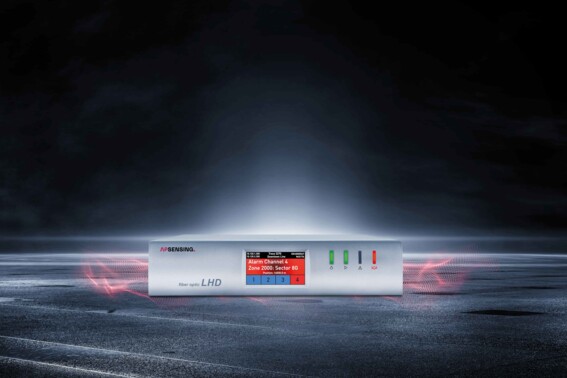The rise in maritime transportation of electric vehicles has rekindled an ever-present debate on improving safety measures for ships and vessels. Developing and demonstrating new procedures and technical innovations for fire detection on RoRo (roll-on/roll-off) and LoLo (lift-on/lift-off) decks has become a key challenge. Distributed fiber optic sensing is a robust solution for detecting, confirming, and localizing fires, providing continuous, real-time monitoring to enhance fire safety on board.
Fire Hazards Unique to Cargo Vessels
Vessels at sea face unique fire risks due to their design and operational demands, with confined cargo holds and machinery spaces increasing fire hazards. Flammable materials, such as lithium-ion batteries in electric vehicles/containers, electrical connections to reefer units in trucks/containers, or cars with conventional combustion engine, pose manifold challenges, as fires can develop and spread quickly in the closely spaced cargo, making them difficult to control. Machinery areas are also vulnerable due to flammable fluids and high-temperature operations. Furthermore, vessels at sea are isolated from help and often run on small crew, which makes quick, reliable and robust detection paramount for first response. Without advanced fire detection systems, fires on cargo ships can result in severe consequences, including threats to human life, financial losses, operational downtime, and environmental damage.
Early fire detection systems provide critical minutes to respond to potential fires before alarms trigger, significantly improving the chances of extinguishing the fire and minimizing damage.
Fiber Optic Linear Heat Detection
Fiber optic Linear Heat Detection (LHD) is well-suited for different categories of cargo ships, requiring only a passive, lightweight sensor cable for effective deployment.
Utilizing the Raman effect, a Linear Heat Detection system uses optical fibers as continuous temperature sensors. These truly distributed systems respond to heat equally at any point along the cable, producing a continuous temperature profile for precise monitoring. This setup allows for accurate temperature readings, pinpointing the location of hotspots within meters, and therefore providing early detection and localization of abnormal heat increases.
Advanced Fire Detection with AP Sensing's LHD
AP Sensing’s fiber optic Linear Heat Detection system meets the need for early fire detection on ships. Our Linear Heat Detection (LHD) system monitors the spread of a fire independently of air movement, providing precise fire detection and localization. It maintains its monitoring functions even at extreme temperatures, up to 750 °C (1400 °F), which is crucial in critical fire scenarios.
Using distributed fiber optic technology allows seamless monitoring across an area, ensuring gapless coverage for fire detection. Early detection of abnormal heat increases triggers alarms at specific higher temperatures or gradients, enhancing the fire safety response on vessels.
The LHD N45-Series is thoroughly tested, confirming its safety and performance under severe conditions.

- Early detection of temperature changes and hotspots
- Precise location of multiple fire events
- Fire size and spread monitoring

Advantages of Fiber Optic LHD
Maximum Safety and Protection
AP Sensing’s fire detection system, the LHD N45-Series, is unaffected by air currents and hence accurately determines the location, the size and direction of a spreading fire. No other fire detection system can withstand temperatures up to 750 °C (1400 °F) and sustain even harsh conditions like dust or humidity, without losing monitoring capability.
Customizable Alarm Management
AP Sensing’s fiber optic LHD systems support smart alarm configuration, offering five distinct alarm criteria for rapid detection. The system allows flexible zone and alarm setups, enabling tailored monitoring for specific areas and quick, reliable fire alerts.
SmartVision Software: Easy Integration and Superb Insight for Operators
AP Sensing’s SmartVision alarm management system provides a comprehensive overview of fire detection status through intuitive asset visualization. With color-coded temperature displays and schematic layouts, SmartVision enables easy orientation and real-time monitoring of all configured Linear Heat Detection (LHD) instruments. Designed for seamless integration, our fiber optic LHD solution connects effortlessly with existing management platforms (SCADA systems). In the event of an alarm, the LHD controller instantly transmits detailed information to the fire control panel, ensuring rapid response and enhanced safety.
Integration of fire detection and suppression systems, as well as well-informed first response by the crew, enhance comprehensive fire safety, ensuring rapid detection and swift extinguishment to minimize damage and protect lives.
Compliance and Certification
SOLAS compliance is mandatory for vessels to operate internationally, emphasizing the importance of effective fire detection systems. These regulations ensure that fire detection systems are thoroughly tested and meet international standards.
Our fiber optic LHD N45-Series is compliant to SOLAS, thoroughly tested and certified (DNV, EN (VdS), UL, ULC, FM, KFI, SIL2, IECEx, ATEX) with the industry's fastest fire detection and lowest false alarm rate.
Key Takeaways
- Easy-to-install with a single passive ⌀ 4 mm sensor cable
- Unaffected by air currents and immune to dirt, dust and humidity
- Functional even at 750 °C for 2 h according to IEC 60331-25
- Flexible zone and alarm configuration
- Compliant with SOLAS and the most complete set of fire certifications
With a proven track record and continued innovation, AP Sensing offers a completely integrated, end-to-end solution made in Germany. Our team works together with you to select the right combination of technologies to fit your requirements. We also provide onsite services, hotline and online support, maintenance and product training.
Find all our brochures, application flyer, product flyers, videos and further case studies in our media library.
What is important when selecting a fiber optic LHD system? Is it wrong to equate measurement time with response time? How many channels are optimal for your configuration?
Frequently Asked Questions
Why Are Fire Detection Systems Crucial for RoRo and LoLo Ships?
Fire detection systems are crucial for RoRo and LoLo ships as they enable early detection and prevention of fire incidents, safeguarding lives, cargo, and the integrity of the vessel.
What Are the Unique Fire Hazards on RoRo and LoLo Ships?
RoRo and LoLo ships are particularly at risk for fires due to confined spaces, presence of flammable materials in cargo holds, and the potential for thermal runaway in electric vehicles. Addressing these hazards is crucial for ensuring safety on board.
How Do Advanced Fire Detection Technologies Enhance Safety on RoRo and LoLo Ships?
Advanced fire detection technologies enhance safety on RoRo and LoLo ships to ensure accurate and early detection of fires, which significantly reduces false alarms and improves response times. This proactive approach creates a safer environment for all aboard.
How Does Onboard Remote Monitoring Improve Fire Detection on Ships?
Onboard remote monitoring enhances fire detection on ships by providing continuous oversight, allowing for real-time responses that minimize damage during fire incidents. This proactive approach significantly improves safety and operational efficiency.



